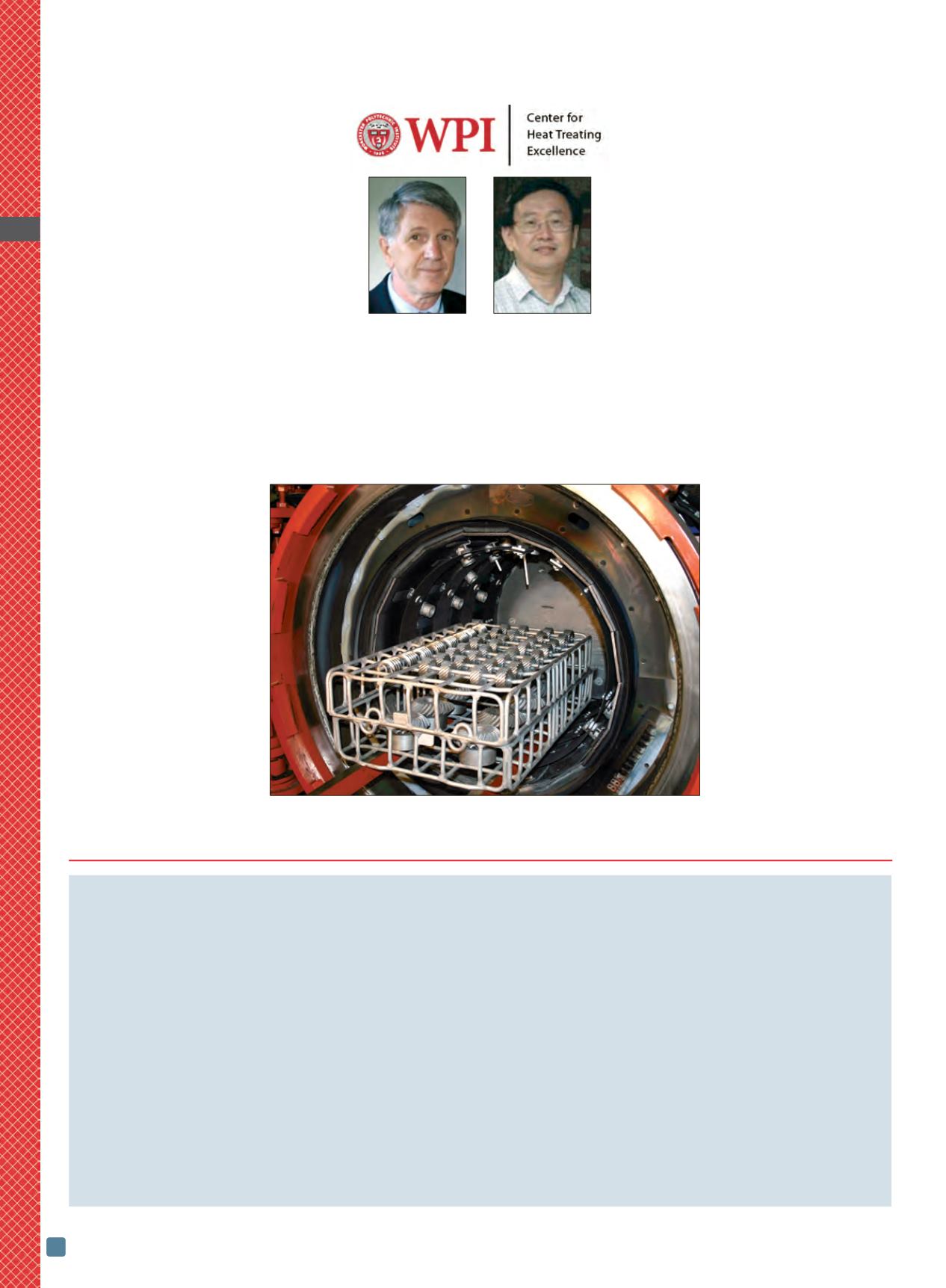

Because alloy steel hardenability is such an
important factor in part manufacturing, the
Center for Heat Treating Excellence (CHTE)
is conducting research aimed at learning
more about the performance of gas quenching
systems used to harden newer alloy steels. The
primary goal of the study is to establish a stan-
dard method to evaluate gas-quench steel
hardenability. Heat transfer coefficients will be
determined for different gas pressures and dur-
ing the cooling phase.
“The world is improving its alloys,” notes
Richard D. Sisson, George F. Fuller professor of
Mechanical Engineering at WPI and director of
CHTE. “New alloys are being developed to be
much harder and to be processed by gas
quenching, and we need to understand how
these alloys perform. We also need to be able
to characterize how fast new furnace designs
can cool the part.”
Another objective of the re-
search project is to evaluate
the cooling performance of
high-pressure gas-quench sys-
tems. Researchers will explore
what equipment is needed
and what conditions are re-
quired to ensure the desired
hardenability standard.
CHTE member Lynn Ferguson
of DANTE Solutions explains,
“Newer furnaces with higher
cooling capability can quench
using gas pressures of 10 to
20 bar. High-pressure gas
quenching (HPGQ) is gaining market share in the United States,
but because gas quenching is a slower process than oil quench-
ing, hardenability becomes more critical.”
Though it is a slower process, HPGQ is dis-
placing oil quenching, especially in Europe,
because it avoids part discoloration, quenching
vapors, potential for fires, and other cleanliness
and environmental issues associated with the
use of oil.
The project is being conducted through simula-
tion and lab testing, with much of the work
being carried out simultaneously. Researchers
are working with commercial software compa-
nies like DANTE Solutions, Dassault Systèmes
Simulia Corp. (ABAQUS) and Sente Software Ltd.
(JMatPro), whose software can simulate the re-
sponse of heat-treated parts. Specifically, sim-
ulations help researchers understand the
relationship between steel hardenability and
cooling performance in gas-quench systems.
The simulations also help
predict the actual behavior of
the parts given the amount
of gas used.
Currently, lab testing is being
conducted at WPI and will
eventually be conducted in
manufacturing
facilities.
Notes Kevin Rong, Higgins
Professor of Mechanical Engi-
neering and director of the
Computer-Aided Manufactur-
ing Laboratory at WPI, and
principal investigator for the
project, “In our testing to
date, we compared liquid
quenches with gas quenches
to identify how the microstructures of the material behave and
determine the differences. The findings have been interesting.”
ADVANCED MATERIALS & PROCESSES •
SEPTEMBER 2014
52
Developing Gas Quench Steel Hardenability Standards
HTPRO
6
About CHTE
The CHTE collaborative is an alliance between the industrial sector and university researchers to address short-term and long-term
needs of the heat-treating industry. Membership in CHTE is unique because members have a voice in selecting quality research proj-
ects that help them solve today’s business challenges.
Member research process
Research projects are member driven. Each research project has a focus group comprising members who provide an industrial per-
spective. Members submit and vote on proposed ideas, and three to four projects are funded yearly. Companies also have the op-
tion of funding a sole-sponsored project. In addition, members own royalty-free intellectual property rights to precompetitive
research, and are trained on all research technology and software updates.
CHTE also periodically undertakes large-scale projects funded by the federal government or foundations. These endeavors keep mem-
bers informed about leading edge technology.
CHTE current research portfolio
Other projects now in progress include:
Nondestructive Testing for Hardness and Case Depth, Induction Tempering, Gas Quench Steel Hardenability, Enhancements to CHTE
Software (CarbTool, CarboNitrideTool, and NitrideTool), and Cold Spray Nanomaterials (supported by ARL).
For more information about CHTE, its research projects, and member services, visit
wpi.edu/+chte, call 508.831.5592, or email Rick
Sisson at
sisson@wpi.edu, or Diran Apelian at
dapelian@wpi.edu.
CHTE member
Lynn Ferguson,
FASM, president
of DANTE
Solutions.
High-pressure
gas-quenching
nozzles in
vacuum furnace
chamber.
Professor Yiming
(Kevin) Rong,
Higgins
Professor of
Mechanical
Engineering and
director of the
Computer-Aided
Manufacturing
Laboratory at
WPI.


















